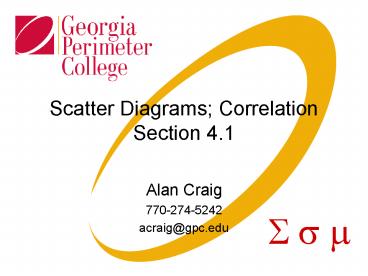Scatter Diagrams Correlation Section 4'1 PowerPoint PPT Presentation
1 / 18
Title: Scatter Diagrams Correlation Section 4'1
1
Scatter Diagrams CorrelationSection 4.1
- Alan Craig
- 770-274-5242
- acraig_at_gpc.edu
2
Objectives 4.1
- Draw scatter diagrams
- Interpret scatter diagrams
- Understand the properties of the linear
correlation coefficient - Compute and interpret the linear correlation
coefficient
3
Variables
- Recall from Chapter 1 that the response variable
is the variable of interest and the factors that
affect the response variable are the predictor
variables. - Lurking variables may also affect the response
variable but have not been identified in the
study.
4
Variables
- Definition
- The response variable is the variable whose value
can be explained by or determined by the value of
the predictor variable(s). - Lurking variables are related to the response or
predictor variables (or both) but are not
included in the study
5
Example Variables
- In a study of a number of different automobile
models, the weight of the car and the drive ratio
of the car were used as variables to predict fuel
consumption. Tire inflation pressure can also
affect fuel consumption but was not studied. - Response variable fuel consumption
- Predictor variables weight of car, drive ratio
- Lurking variable tire inflation pressure
6
Scatter Diagram
- Definition
- A graph that shows the relationship between two
quantitative variables measured on the same
individual. - Predictor variable is on the x-axis
- Response variable is on the y-axis
7
Scatter Diagrams
Linear--Negative
Response
Response
Linear--Positive
Predictor
Predictor
Response
Response
Nonlinear
No Relationship
Predictor
Predictor
8
Interpreting Scatter Diagrams
- Positively correlatedif predictor variable
increases , so does the response variable .
(positive slope) - Negatively correlatedif the predictor variable
increases , then values of the response variable
decrease . (negative slope)
9
Example, Prob 12 p.157
- (Scatter plot done in SPSS)
- Are the variables positively or negatively
correlated?
10
Example, Prob 12 p.157
- (Scatter plot done in calculator)
- See handout for calculator instructions.
11
Linear Correlation
- The linear correlation coefficient measures the
strength of the linear relationship between two
quantitative variables. - r (Greek letter rho) is used for the population
correlation coefficient and r for the sample
correlation coefficient. - It is also called the Pearson product moment
correlation coefficient.
12
Sample Correlation Coefficient
sx and sy are the standard deviations of x and y,
respectively. Note the n - 1
13
Properties of the Linear Correlation Coefficient
- -1 r 1
- r 1 ? perfect positive linear relation
- r -1 ? perfect negative linear relation
- Closer r is to 1 or -1 the stronger the relation
(positive or negative) - r close to 0, no linear relation
- Unit of measure of x, y does not matter, r is
unitless
14
Example, Prob 12 (c/d) p.157
- (c) Compute the linear correlation coefficient
between the number of carats and the price of a
diamond. - (d) Comment on the type of relation that appears
to exist between the number of carats and price. - See the handout for calculator instructions.
15
Example, Prob 12 p.157
- r .9917
- In section 4.2/4.3, we will discuss the other
items.
- (d) Type of relationship?
16
Example, Prob 12 (e) p.157
- (e) Remove the diamond that weighs 1.18 carats
from the data set and recalculate r. - What is the effect of removing this data point?
- Why do you think this happened?
17
Example, Prob 12 (e) p.157
- r .9707
- Less than before.
- Why?
18
Questions
- ???????????????

